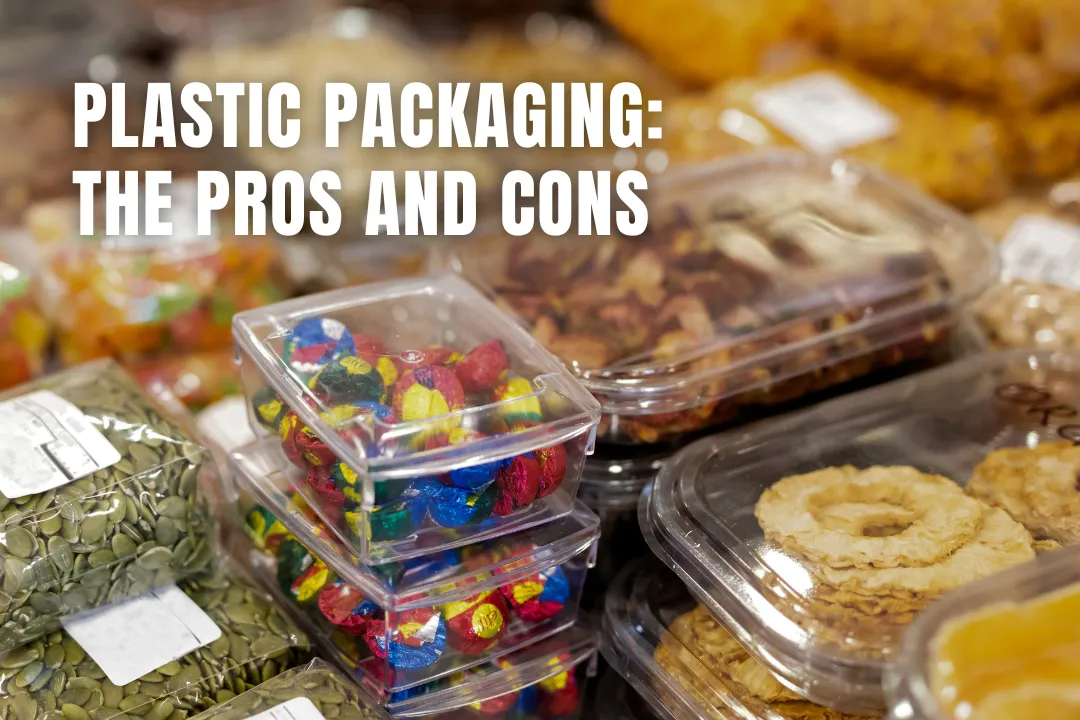Plastic Packaging: The Pros And Cons
August 13, 2025

When choosing packaging for your product, there are a few different materials to select from. Plastic is a popular option that is used for everything from food containers to medication blister packs. There are many benefits to using plastic, but also several drawbacks. To help you decide whether to use plastic or not, here is a deep dive into the pros and cons.
Key Takeaways on Plastic Packaging
- Cost-Effective and Lightweight: Plastic packaging is often cheaper to produce than other materials and its light weight can help reduce shipping costs and emissions.
- Durable and Protective: It is very strong, resists damage from moisture, and can contain corrosive substances, making it suitable for fragile or sensitive items.
- Airtight and Versatile: Plastic creates an excellent barrier against air and moisture, preserving perishable goods. It can also be formed into many different shapes and consistencies.
- Energy Use in Production: While plastic production uses energy, it generally requires less than materials like cardboard or metal.
- Environmental Persistence: Plastic does not break down easily, contributing to landfill issues, with some types taking hundreds of years to decompose.
- Recycling Challenges: Recycling plastic is complicated due to the many different types and the energy-intensive sorting and melting processes involved.
- Resource Dependency and Pollution: Most plastics are made from petroleum, a finite resource. They also contribute to microplastic pollution, which disperses tiny particles into the environment and our bodies.
- Potential for Leaching: Over time, chemicals from plastic can transfer into stored food or liquids, affecting taste and leading to the ingestion of microplastics.
- Regulatory Restrictions: Environmental concerns have led many countries to ban certain types of plastic, particularly disposable forms, though reusable plastic is generally unaffected.
Register Your LLC
Company Registration
START NOW
The Pros of Plastic Packaging
Low cost
Plastic packaging is often cheap to produce - more so than most other materials. This makes it an attractive solution for those wanting a budget solution. Just be wary that different countries have different taxes, which can greatly affect the price.
Lightweight
Because plastic is very lightweight, it is often easier to ship in bulk than other materials. This can lead to reduced shipping costs and shipping emissions. Of course, it does depend on the type of plastic as to just how heavy it is.
Robust
Plastic is incredibly robust. Whereas materials like cardboard can be easily ripped or can get soggy, plastic tends to hold its form well. This is why it is commonly used to package fragile items. On top of this, plastic is one of the few materials able to contain corrosive substances like bleach.
Airtight
Unlike some other materials, plastic does not let air or moisture in. It is excellent for preserving foods and other perishable goods for this reason.
Versatile
The versatility of plastic cannot be beaten. Using manufacturing methods like vacuum forming plastic and injection molding, it’s possible to turn plastic into all kinds of shapes that are considerably harder to produce using other materials. Plastic can also come in various consistencies from a stretchable wrap to a hard casing.
Energy-efficient
While the production of plastic does require energy to produce, it is generally less than materials like cardboard and metal. Other aspects of plastic production make it less green, but this is an area where it does exceed other materials.
The cons of plastic packaging
Non-biodegradable
Plastic does not decompose easily like other materials and is gradually filling up landfill sites across the world. Specific plastics like PET are particularly bad for this - taking an estimated 450 years to decompose. A few newer biodegradable plastics have been produced and are likely to become more popular in the future, but are still relatively pricey compared to other plastics.
Hard to recycle
Plastic can be recycled, but the process is not easy as it is with paper or metal. There are many different types of plastic and no simple way to divide them. Sorting plastics and melting them down to create new plastic can be a laborious and energy-guzzling process.
Fossil-fuel reliant
Most plastics are petroleum-based. This is a finite resource. Other materials like cardboard are more sustainable, because trees can be continuously replanted.
Polluting
One of the biggest pollutants right now is microplastics. When plastic does eventually break down, it disperses millions of plastic particles into the air, earth and water. These microplastics are even inside our bodies and the damage caused by these is not yet determined.
Leaching
While plastic is generally safe to use for food and liquid packaging, long term storage may lead to leaching. This is when plastic contaminates the liquid or food, which affects taste and leads to ingestion of indigestible microplastics.
Legally restricted
Due to environmental concerns, many countries have placed bans on certain types of plastic for certain uses. Many forms of disposable plastic are being banned, however reusable plastic and plastic packaging designed for long term use is generally unrestricted.
Conclusion
Whether to use plastic or not all comes down to the type of product you are packaging and who your audience are. It is difficult to find a safe and suitable plastic alternative for many products like medications and cleaning chemicals. In other cases, there are available alternatives that - although not quite as practical - may be more eco-friendly. This may appeal to certain consumers.

